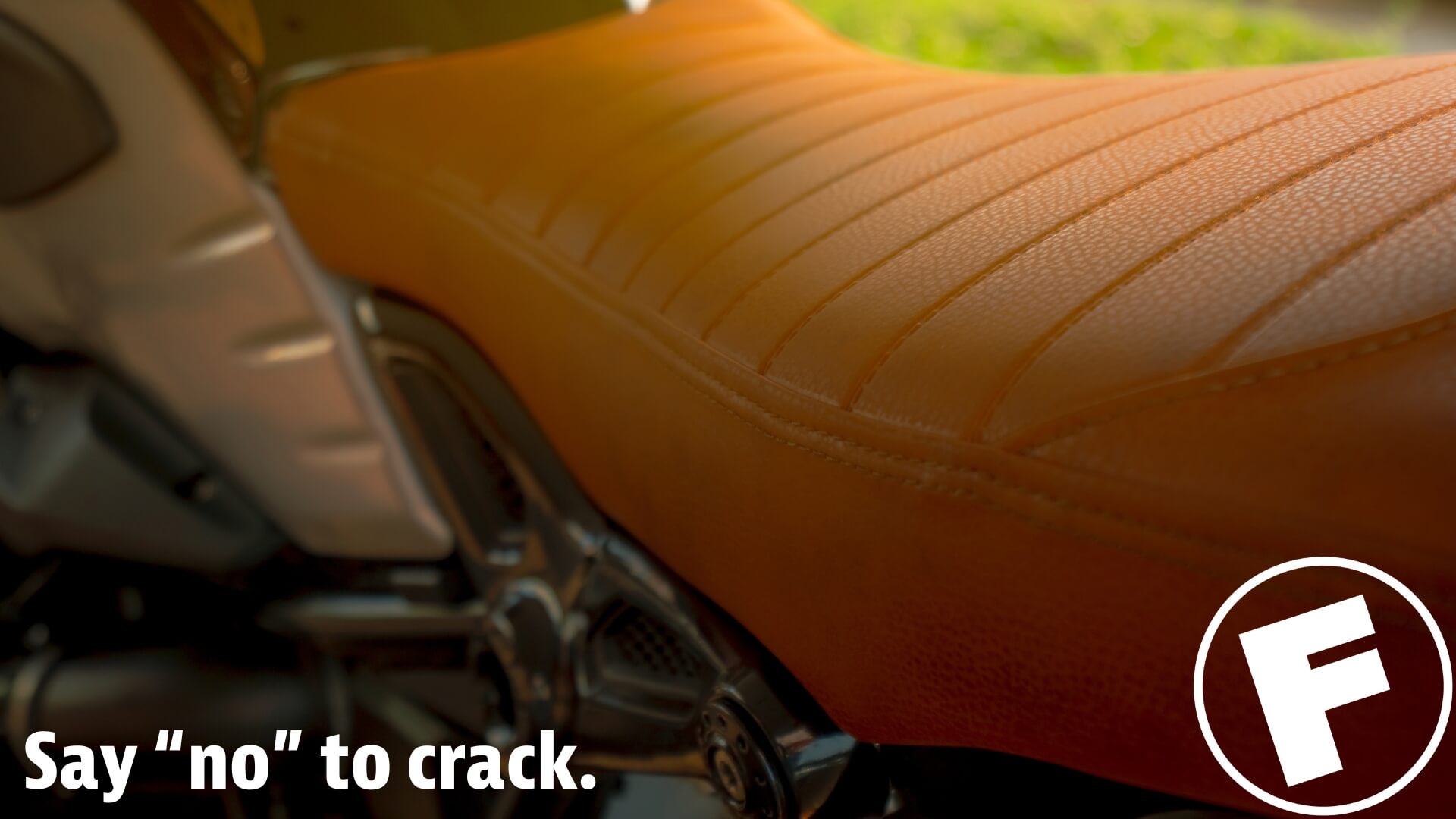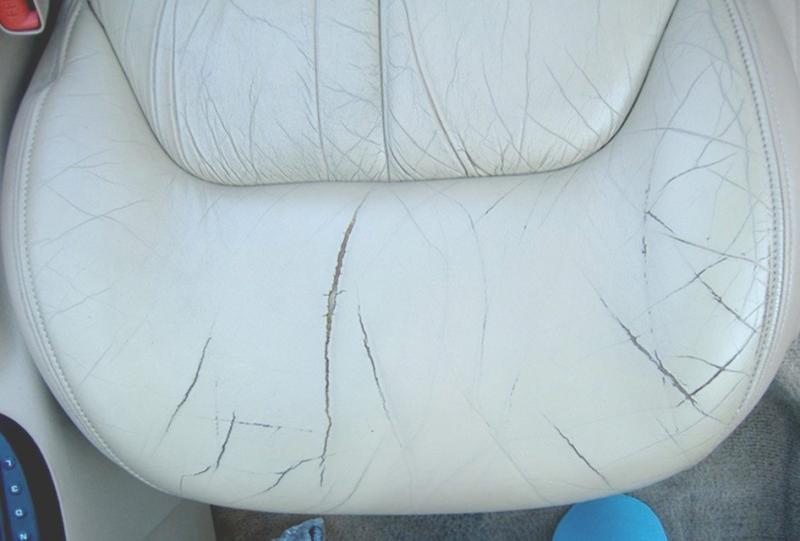Why Leather Car and Motorcycle Seats Crack
Most car interior leather and motorcycle seats are fully finished, real leather, and there are a couple of reasons why it cracks. Cracking usually occurs when the protective coating on the seat leather is worn down or when there has been a manufacturing problem.
So if you see your driver’s seat suddenly split or rips open, here are some reasons why—plus some preventative measures you can take. Read on.

The two main culprits for cracked leather car seats
There are two primary reasons to be mindful of that can lead to rapid cracking of leather car or motorcycle seats.
1. Body oil and dirt can cause the leather to crack
It is very easy for dirt and oils to collect on the seating surfaces. Together, these act like fine sandpaper, breaking down the protective layer on fully finished leather over time, eventually leading to visible cracks at the surface.
Once the protective layer is broken down, the leather underneath, which is incredibly porous, soaks up the dirt and oil sitting on its surface causing further abrasion and damage.
2. A manufacturer problem can cause the leather to crack
Tanneries put a layer of dye and a protective top coating on cowhide (almost like paint on drywall) to make fully finished leather.
Leather has a lot of give and will stretch and move as people sit and slide around on it, so the manufacturer needs to stretch it properly before they put on the dye and protective top coating.
If they don’t stretch it well, the leather will quickly stretch more than the leather dye can handle, and the coating will crack. This is why even brand new leather seats are at risk sometimes.
Once leather is cracked, a Fibrenew professional can typically fix any piece of leather, however, it is much cheaper and easier to clean and take care of your leather seats from the start than to deal with cracking after it happens.

Cracked leather car seat
Other reasons for cracked leather car and motorcycle seats
It’s important to regularly use leather cleaner and condition leather seats, avoid prolonged exposure to sunlight, and be cautious with the products used on them.
- Drying Out: Leather is a natural material that contains oils and moisture. Over time, exposure to sunlight, heat, and dry conditions can cause the leather to lose its moisture content, making it dry and brittle. This dehydration leads to cracking.
- Lack of Maintenance: Failure to regularly clean, condition, and protect leather seats can accelerate the drying-out process. Cleaning and conditioning help maintain the leather’s natural oils and flexibility, preventing cracks from forming.
- UV Exposure: Prolonged exposure to ultraviolet (UV) rays from sunlight can cause leather to fade, weaken, and become more prone to cracking. Tinted windows or parking in shaded areas can help reduce UV exposure.
- Temperature Fluctuations: Extreme temperature changes, especially excessive heat, can cause leather to expand and contract, leading to stress on the material, which may result in cracks over time.
- Low-Quality Leather: The quality of the leather used in car and motorcycle seats matters. Lower-quality leather or faux leather may not be as durable and can crack more easily than high-quality, genuine leather.
- Wear and Tear: Daily use, friction from clothing, and pressure from sitting can contribute to the gradual wear and tear of leather seats, making them more susceptible to cracking.
- Poor Installation: Improper installation or tension in the leather during the upholstery process can lead to stress points where cracks may form.
Keep new seats in good shape through maintenance
To prevent leather car and motorcycle seats from cracking, consider the following maintenance tips:
- Regular Cleaning: Clean the leather seats with a leather-specific cleaner to remove dirt, grime, and oils. Avoid using harsh or abrasive cleaning products.
- Conditioning: Apply a leather conditioner regularly to keep the leather supple and moisturized. Conditioning helps replenish the natural oils in the leather.
- UV Protection: Use window tints, sunshades, or park in shaded areas to reduce exposure to direct sunlight.
- Temperature Control: If possible, park in a garage or covered area to protect the seats from extreme temperatures.
- Quality Leather Care Products: Use high-quality leather care products specifically designed for automotive or motorcycle seats.
- Regular Inspection: Periodically inspect the seats for any signs of wear or early cracking, so you can address issues promptly.
- Professional Upholstery: If the leather seats have significant damage or cracks, consider professional repair or reupholstering by experts who specialize in leather restoration.
Proper care and maintenance can extend the life of leather car and motorcycle seats, keeping them looking and feeling good for years to come.
Contact Fibrenew to appease your leather woes
Cracking of fully-finished leather is actually a very common problem that leather restoration experts can easily fix, but like most things with leather car or motorcycle seats, it’s easier (and cheaper) to take care of the problem before it really becomes a problem.
Remember, leather is a natural material and may show signs of wear over time. Regular care and maintenance can prevent further damage and prolong the life of your leather items.
Get in touch with Fibrenew today for all your leather repair needs, or to become an expert and join the family!
Why do leather car and motorcycle seats crack? Leather seats can crack due to factors like drying out, lack of maintenance, UV exposure, temperature fluctuations, low-quality leather, wear and tear, and poor installation. How can I prevent leather seats from cracking? To prevent cracking, regularly clean and condition your leather seats, protect them from UV rays and extreme temperatures, and use high-quality leather care products. How often should I clean and condition my leather seats? It’s recommended to clean and condition leather seats every 1-3 months, depending on usage and environmental conditions. Inspect the seats regularly and adjust your schedule accordingly. What type of cleaner and conditioner should I use on leather seats? Use leather-specific cleaning and conditioning products. Avoid harsh or abrasive cleaners that can damage the leather. Can I use household products to clean and condition leather seats? It’s best to use products specifically designed for leather care, as household products may contain ingredients that can harm the leather. How can I protect leather seats from UV damage? Use window tints, sunshades, or park in shaded areas whenever possible to reduce direct sunlight exposure. What can I do to minimize temperature-related cracking? Park in a garage or covered area to protect the seats from extreme heat or cold. Using seat covers can also help insulate against temperature fluctuations. How can I tell if my leather seats are low-quality? Low-quality leather may feel less supple, may crack more easily, and exhibit uneven coloring. Genuine leather is more durable and maintains its quality over time. Can cracked leather seats be repaired? Yes, cracked leather seats can often be repaired or restored by professionals who specialize in leather upholstery and restoration. What should I do if my leather seats already have cracks? If your seats have cracks, consult a professional for repair options. Addressing the issue promptly can prevent further damage. Are there any DIY methods to repair small cracks in leather seats? While some DIY leather repair kits are available, it’s best to consult a professional for proper repairs, especially for significant cracks. Can I use leather protectants as a substitute for conditioning? Leather protectants primarily provide a barrier against stains and spills. While they can offer some protection, regular conditioning is essential for maintaining the leather’s suppleness and preventing cracking. Can I use water to clean leather seats? Water alone is not recommended for cleaning leather, as it can cause drying and potential damage. Always use a leather-specific cleaner. Can I prevent wear and tear on leather seats? You can reduce wear and tear by using seat covers, being mindful of sharp objects and clothing accessories, and avoiding excessive friction. Is it worth investing in high-quality leather seats for my car or motorcycle?Car and Motorcycle Leather Seat Cracking FAQ


